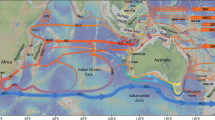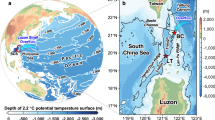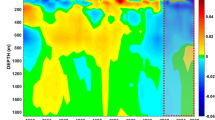Abstract
Recent papers (for example, refs 1 and 2) have raised the possibility, perhaps of global significance, that the rate of interbasin mass exchange between the Pacific and Indian Oceans through the Indonesian archipelago (referred to as the throughflow) is far higher than the value of 1–2 Sv (1 Sv = 106 m3 s−1) originally suggested in ref. 3. The elevated temperature and depressed salinity of throughflow water have a critical role in the heat and freshwater balance of the Indian Ocean4. Inasmuch as the Indonesian through-flow route is the only interocean basin connection in tropical latitudes, its presence and strength have important implications to heat flux through the global ocean5. Present estimates of the magnitude of the throughflow are all by various indirect methods and vary greatly, from 1.5 to 20 Sv (refs 1–3, 6–8 reviewed in ref. 5). We present here direct (current meter) observations that support the existence of a large throughflow.
This is a preview of subscription content, access via your institution
Access options
Subscribe to this journal
Receive 51 print issues and online access
$199.00 per year
only $3.90 per issue
Buy this article
- Purchase on Springer Link
- Instant access to full article PDF
Prices may be subject to local taxes which are calculated during checkout
Similar content being viewed by others
References
Godfrey, J. & Golding, T. J. phys. Oceanogr. 11, 771–779 (1981).
Piola, A. & Gordon, A. J. phys. Oceanogr. 14, 747–753 (1984).
Wyrtki, K. NAGA Report 2 (1961).
Toole, J. & Raymer, M. Deep Sea Res. 32, 917–928 (1985).
Gordon, A. J. geophys. Res. 91, 5037–5046 (1986).
Cox, M. Numerical Models of Ocean Circulation (National Academy Press. Washington, DC, 1982).
Fine, R. Nature 315, 478–480 (1985).
Fu, L. J. phys. Oceanogr. 16, 1683–1693 (1986).
United States Naval Oceanographic Office, Spec. Pub. 1404-IN 5 (NSTL Station, Michigan, 1977).
Murray, S., Hecht, A. & Babcock, A. J. mar. Res. 42, 265–287 (1984).
Lek, L. Die Ergebnisse der Strom und Serienmessungen, The Snellius Expedition Vol. II, Part 3 (Brill, London, 1938).
Wyrtki, K. J. geophys. Res. 92, 12941–12946 (1987).
Gill, A. Atmosphere-Ocean Dynamics (Int. Geophys. Ser., 30) (Academic, New York, 1982).
Killworth, P. J. phys. Oceanogr. 3, 3–15 (1973).
Okubo, A. Tech. Rept. 38, Chesapeake Bay Inst. (Johns Hopkins Univ., Baltimore, 1968).
Arief, D. & Murray, S. Eos 68, 1746 (1987).
Tee, K. T. J. phys. Oceanogr. 7, 396–402 (1977).
Kindle, J., Heburn, G. & Rhodes, R. in Further Progress in Equatorial Oceanography (eds Katz, E. J. & Witte, J. M.) 317–321 (Nova Univ. Press, Fort Lauderdale, 1987).
Author information
Authors and Affiliations
Rights and permissions
About this article
Cite this article
Murray, S., Arief, D. Throughflow into the Indian Ocean through the Lombok Strait, January 1985–January 1986. Nature 333, 444–447 (1988). https://doi.org/10.1038/333444a0
Received:
Accepted:
Issue Date:
DOI: https://doi.org/10.1038/333444a0
This article is cited by
-
Oceanic internal solitary waves at the Indonesian submarine wreckage site
Acta Oceanologica Sinica (2022)
-
Seasonal and interannual variability of water mass sources of Indonesian throughflow in the Maluku Sea and the Halmahera Sea
Acta Oceanologica Sinica (2019)
-
Long-term isolation and local adaptation in Palau’s Nikko Bay help corals thrive in acidic waters
Coral Reefs (2016)
-
The annual mean sketches and climatological variability of the volume and heat transports through the inter-basin passages: A study based on 1 400-year spin up of MOM4p1
Acta Oceanologica Sinica (2014)
-
Indonesian Throughflow in an eddy-resolving ocean model
Chinese Science Bulletin (2013)
Comments
By submitting a comment you agree to abide by our Terms and Community Guidelines. If you find something abusive or that does not comply with our terms or guidelines please flag it as inappropriate.



